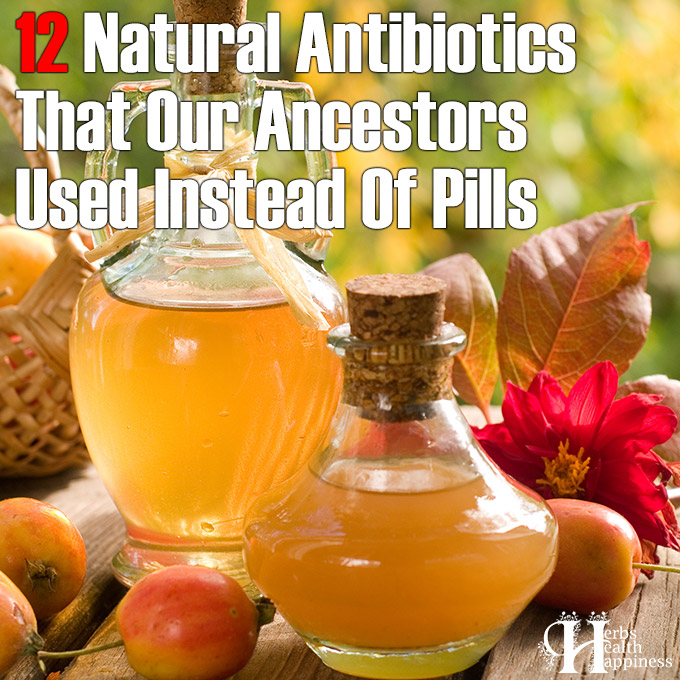
12 Natural Antibiotics That Our Ancestors Used Instead Of Pills. Graphic © herbshealthhappiness.com. Background photo © AdobeStock 44600982 (under license).
Antibiotics are commonly regarded as the most over-prescribed of all medicines. Having been massively overused as a “short-term fix”, we now have a huge global problem: Antibiotic resistant bacteria.
Drug-resistant, difficult-to-treat bacterial infections such as MRSA (Methicillin-resistant Staphylococcus aureus) and Clostridium difficile have become very resistant to the strongest of antibiotics. This makes sense if you consider it: “Attacking” the bacteria with isolated molecular components literally forces the bacteria to evolve due to their incredibly rapid process of natural selection.
The world of medicine has been forced to revisit the use of older antimicrobials that had previously been discarded. Here are some of the many things used as antibiotics in ancient times – and the science that shows that the ancients may have known much more about medicine than we give them credit for…
1: Oregano Oil
Oregano has been regarded as beneficial against bacterial infections since very old days. Oregano oils and extracts have seen a massive resurgence in use in modern times as natural cold remedies (oregano extract) and lab research has indicated they are powerfully active against food-borne stomach illness bacteria, including the dreaded E. Coli. [1]
Oregano leaves and extracts have been shown by scientists to have anti-inflammatory and anti-microbial properties against airway infections, proven in an in-vivo study published in 2014. [2]
2: Apple Cider Vinegar
Acetic acid or vinegar, specifally apple cider vinegar, is a popular natural household cleansing agent because of it antibacterial properties. However, it can also be used raw and unfiltered as a skin cleansing agent or a natural antibiotic for the common cold when mixed in with warm water. [3]
3: Honey
Honey is one of the oldest known remedies to fight infection. In a recent study, manuka honey was proven to be effective in fighting biofilm bacteria, or strains are known to be resistant to most antibiotics. If you have a cold or cough, try mixing a little bit of honey in warm water and drink it two to three times a day. [4]
4: Turmeric
Staphylococcus aureus and E.coli are two of the most common infection-causing bacteria in humans, and are two of the most difficult strains to cure. Turmeric paste was used in a very recent 2015 study that revealed how it was able to inhibit the growth of both strains. [5]
5: Garlic
Not only is garlic widely regarded as good for the heart and your cholesterol, it is also thought to be effective as an antibiotic against food poisoning bacteria. In the lab, garlic oil has been demonstrated to inhibit the growth of Staphylococcus aureus, E. coli, and Bacillus subtilis. [6]
6: Grapefruit seed extract
The antibacterial properties of grapefruit seed extract have been studied over the years, discovering how it is able to fight the growth of both gram-positive and gram-negative bacteria. It is an effective topical antibiotic, which can be used for mild skin abrasions and irritations. [7]
7: Echinacea
In traditional medicine, the Echinacea plant has been used in North America for the management of a variety of infections and wounds. Studies have proven the plant’s anti-inflammatory, antibacterial, and antiviral properties which can fight a variety of infections. [8]
8: Essential Oils
Numerous essential oils have been found to have potent antibacterial qualities. These have been known about since ancient times: “Plague doctors” used to wear masks filled with certain herbs as the aromas from these herbs were thought to prevent the plague from being breathed in by the physician.
Eucalyptus Essential Oil and Tea Tree Essential Oil have been found active against MRSA infections. [9][10]
9: Extra virgin coconut oil
A popular beauty regimen is the use of coconut oil to moisturize the skin and prevent acne. But this is backed by science as well! Coconut oil has been found active in vitro against bacterial strains of clostridium and staphylococcus. [11][12] There may even be some antibacterial support for those oil pulling with coconut oil.
10: Fermented food
Fermented food like vegetables and dairy are rich in probiotics, healthy bacteria that improve our digestive and immune systems. Regular intake of probiotic-rich food and drink has been suggested to prevent infectious diarrhea and upper airway infections. [13][14]
11: Silver
Silver has been known for its antibiotic properties since ancient times. Hippocrates first described its antimicrobial properties in 400 BC. In ancient days, people used to put silver coins in jars of water in the belief in its ability to sterilize them – and it’s thought that one of the reasons people used silver cutlery was that it may have assisted with prevention of food-borne bacteria.
While these uses may not be considered “proven”, the use of silver as an antibiotic is not just an old folk remedy: Did you know that modern bandages and wound treatments are impregnated with silver particles in order to assist prevention of infection? It’s done on a massive scale: In 2006, the UK’s National Health Services spent about 25 million pounds on silver-containing dressings. This represents about 14% of the total dressings used and about 25% of the overall wound dressing costs. [15] Silver compounds are also used in external preparations as antiseptics.
Silver and most silver compounds have been found toxic to bacteria, algae, and fungi in vitro. This is not fringe science: The prestigious journal Nature recently reported that silver “could help to deal with the thoroughly modern scourge of antibiotic resistance”. Silver ions have been found to have a “dual mode” of action against bacterial cells: It makes the cell membrane more permeable, and it interferes with the cell’s metabolism. [16]
Colloidal silver has been found to have potent antimicrobial effects on Staphyloccocus aureus [17] and Proteus bacteria which can cause rheumatoid arthritis. [18]
Note that silver accumulates in the body and taking it internally can potentially lead to argyria, a condition that turns the body’s tissue grey-blue. [16] However, it’s important to realize that this only occurs in people who ingest or inhale silver in large quantities over a long period.
Silver has been found to potentiate the activity of a broad range of antibiotics against Gram-negative bacteria in different metabolic states, as well as to restore antibiotic susceptibility to resistant bacterial strains. [19]
12: Cabbage
Did you know that this vegetable was once called “doctor of the poor”? Used by sailors to prevent scurvy, it was also used as an ancient remedy for tuberculosis. Cabbage leaves have also long been used as a poultice to treat infected wounds. [20]
Numerous modern studies have found antibacterial effects from cabbage. Note that raw cabbage is suggested as cooking may diminish these effects. Shredded raw cabbage makes a great salad ingredient.
Note that cabbage should be avoided by those who have an overactive thyroid gland.
Further Reading:
For a deeper discussion of this fascinating topic and lists of even more antibiotic herbs, check out this top five-star rated book on Amazon:
References:
[1] Antibacterial activity of oregano essential oil (Origanum heracleoticum L.) against clinical strains of Escherichia coli and Pseudomonas aeruginosa] (2012). https://pubmed.ncbi.nlm.nih.gov/23484421
[2] Grondona, E., et. al. (2014). Bio-efficacy of the essential oil of oregano (Origanum vulgare Lamiaceae. Ssp. Hirtum). https://pubmed.ncbi.nlm.nih.gov/25266989
[3] Bragg, P. (2003). Apple Cider Vinegar Health Care System. https://books.google.com.ph/books?isbn=0877905010
[4] Hammond, E., Donkor, E., & Brown, C. (2014). Biofilm formation of Clostridium difficile and susceptibility to Manuka honey. https://pubmed.ncbi.nlm.nih.gov/25181951
[5] Afrose, R., et. al. (2015). Antibacterial Effect of Curcuma longa (Turmeric) Against Staphylococcus aureus and Escherichia coli. https://pubmed.ncbi.nlm.nih.gov/26329948
[6] Guo, Y. (2014). Experimental study on the optimization of extraction process of garlic oil and its antibacterial effects. https://pubmed.ncbi.nlm.nih.gov/25435627
[7] Reagor, L., et. al. (2002). The effectiveness of processed grapefruit-seed extract as an antibacterial agent: I. An in vitro agar assay. https://online.liebertpub.com/doi/abs/10.1089/10755530260128014
[8] Hudson, J. (2012). Applications of the phytomedicine Echinacea purpurea (Purple Coneflower) in infectious diseases. https://pubmed.ncbi.nlm.nih.gov/22131823
[9] Topical application of a new formulation of eucalyptus oil phytochemical clears methicillin-resistant Staphylococcus aureus infection. (American Journal of Infection Control, 2001). https://pubmed.ncbi.nlm.nih.gov/11584265
[10] Holistic Nursing: A Handbook for Practice (p.489). https://books.google.com/books?id=lod3hBf4U7IC&pg=PA489
[11] Shilling, M., et. al. (2013). Antimicrobial effects of virgin coconut oil and its medium-chain fatty acids on Clostridium difficile. https://pubmed.ncbi.nlm.nih.gov/24328700
[12] Tangwatcharin, P.& Khopaibool, P. (2012). Activity of virgin coconut oil, lauric acid or monolaurin in combination with lactic acid against Staphylococcus aureus. https://pubmed.ncbi.nlm.nih.gov/23077821
[13] Issa, I. & Moucari, R. (2014). Probiotics for antibiotic-associated diarrhea: do we have a verdict? https://pubmed.ncbi.nlm.nih.gov/25548477
[14] Hao, Q., Dong, B. & Wu, T. (2015). Probiotics for preventing acute upper respiratory tract infections. https://pubmed.ncbi.nlm.nih.gov/25927096
[15] https://en.wikipedia.org/wiki/Medical_uses_of_silver
[16] “Silver makes antibiotics thousands of times more effective
” – Nature, 2013. https://nature.com/news/silver-makes-antibiotics-thousands-of-times-more-effective-1.13232
[17] Goggin, R., et. al. (2014). Colloidal silver: a novel treatment for Staphylococcus aureus biofilms? https://pubmed.ncbi.nlm.nih.gov/24431107
[18] Disaanayake, D., et. al. (2014). Efficacy of some colloidal silver preparations and silver salts against Proteus bacteria, one possible cause of rheumatoid arthritis. https://pubmed.ncbi.nlm.nih.gov/24390313
[19] Silver Enhances Antibiotic Activity Against Gram-Negative Bacteria (STM, 2013). https://stm.sciencemag.org/content/5/190/190ra81
★ Get My Books - 100% FREE:
😳 Tinnitus And Brain Health?
After 47 years of studies and countless brain scans done on more than 2,400 tinnitus patients, scientists at the MIT Institute found that in a shocking 96% of cases, tinnitus was actually shrinking their brain cells.
As it turns out, tinnitus and brain health are strongly linked.
Even more interesting: The reason why top army officials are not deaf after decades of hearing machine guns, bombs going off and helicopter noises…
Is because they are using something called "the wire method", a simple protocol inspired by a classified surgery on deaf people from the 1950s...
★ How To Get Rid Of Nail Fungus:
★ Does Your Salad Contain This Vegetable?
★ 20 Natural Painkillers In Your Kitchen (Video):
★ Men's Prostate Health:

2. Famous Chef Sheds 60lbs Researching New Paleo Recipes: Get The Cookbook FREE Here
3. #1 muscle that eliminates joint and back pain, anxiety and looking fat
4. 7 odd foods that KILL your abdominal fat (surprising fat-fighters)
5. The TRUTH about bread (Will surprise you!)
6. [PROOF] Reverse Diabetes with a "Pancreas Jumpstart"
7. Here's What Happens When You "Unlock Your Hip Flexors"
8. The #1 WORST food that CAUSES Faster Aging (beware -- Are you eating this?)
The #1 Muscle That Eliminates Joint And Back Pain, Anxiety And Looking Fat
By Mike Westerdal CPT
Can you guess which muscle in your body is the #1 muscle that eliminates joint and back pain, anxiety and looking fat?
This is especially important if you spend a significant amount of time sitting every day (I do, and this really affects me in a big way!)
Working this "hidden survival muscle" that most people are simply not training because no-one ever taught them how will boost your body shape, energy levels, immune system, sexual function, strength and athletic performance when unlocked.
If this "hidden" most powerful primal muscle is healthy, we are healthy.
Is it...
a) Abs
b) Chest
c) Glutes
d) Hip Flexors
Take the quiz above and see if you got the correct answer!
P.S. Make sure you check out this page to get to know the 10 simple moves that will bring vitality back into your life:
If you enjoyed this page:













I need more of the information